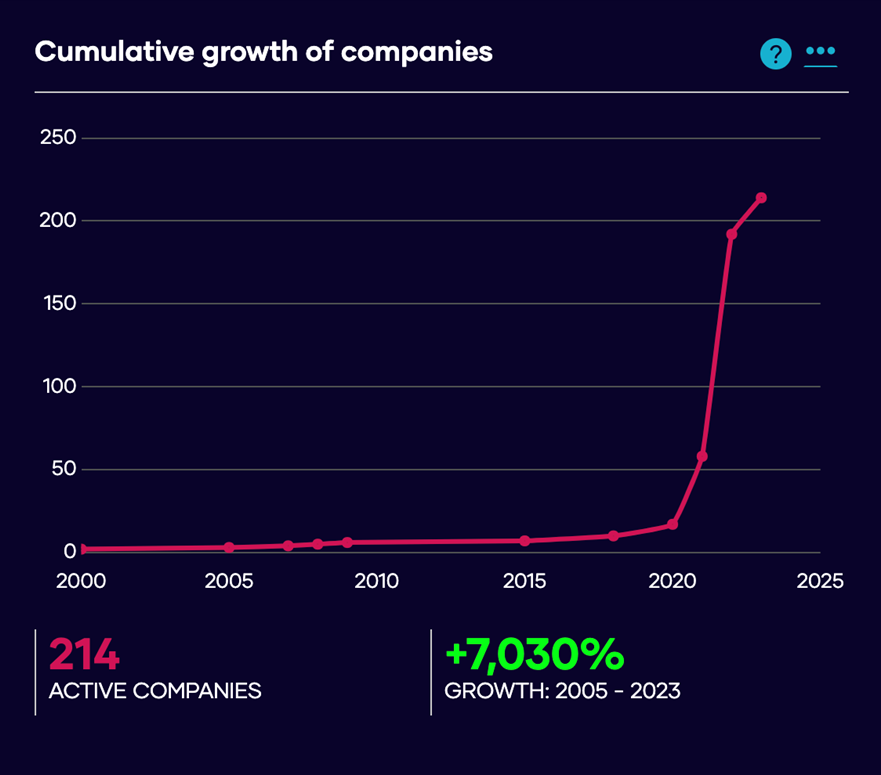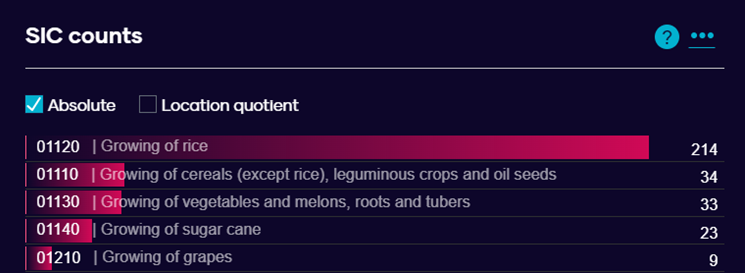Standard Industrial Classification (SIC) codes are not appropriate for analysing emerging economy sectors. We wrote an article in 2020 highlighting the challenges that it poses. These same challenges are greater and more prominent than ever.
SIC codes are vague, outdated and inaccurate
But first, what is an Standard Industrial Classification (SIC) code? There are over 700 SIC codes and the objective of these is to give information to Companies House about what the company does. Companies must select up to four of these themselves when registering in the UK. They are often the basis for analysis and are frequently used to inform national change. This is why it is so important that SIC codes work. But they don’t.
Vague

There are around 740,000 companies in the UK that are not elsewhere classified (n.e.c). This is about 15% of companies in the UK. In other words, without a lot of time and effort, 15% of UK companies cannot be accurately classified and analysed using SIC. To give an example of just how vague SIC codes are, let’s take a look at SIC code 82990—Other business support services n.e.c. Try to define “other business support services”—you can’t. It’s a catch-all category that all manner of businesses could (and do) classify themselves as. Let’s dig deeper:
- AMAZON UK SERVICES LTD.
- SONY INTERACTIVE ENTERTAINMENT NETWORK EUROPE LIMITED
- SANTANDER UK PLC
- GOOGLE UK LIMITED
- FACEBOOK UK LTD
In this list of companies, we have an online retailer/ cloud services provider, a video games company, a bank, a tech/ search engine company and a social media company. These companies should be classified in completely different areas, but according to SIC, they all do the same thing.
Outdated
SIC codes have not been updated in 15 years—the latest version is from 2007. This means that they are completely blind to emerging economic industries. While there are plans to update SIC, this will be a smaller revision and not a fundamental restructuring. The smaller revision we can expect in 2025, and the addition of fundamentally new sectors will be even longer.
Inaccurate
When a company is incorporated a SIC code must be chosen. A company can have up to four SIC codes. There are no real penalties for choosing incorrect SIC codes which can result in choices of convenience instead of accuracy. After all, many are going to choose the path of least resistance.
Without enforcement and verification that the SIC code matches what the company does, analysis can be distorted. For example, if you wanted to know which sectors are growing the fastest after the pandemic using SIC, you would find that there has been a rapid increase in the number of rice growers in the UK.

It’s not possible to grow rice in the UK, but this sector grew by a factor of 20 in the post pandemic years. Coincidentally, the growing of rice is one of the first in the entire list of 731 SIC codes. The sectors most associated with the rice SIC are codes that are adjacent in the list.

Conversely, what if we wanted to understand struggling sectors? A reasonable place to start might be looking at dormant companies. There are 142,601 active companies in this SIC code boasting an average 8.8% annual growth rate and £31 billion in turnover. A dormant company should not have any significant income as it shouldn’t be trading. Despite this, dormant companies are showing large amounts of growth and turnover according to SIC.

This just shows yet another failure of SIC – companies have no incentive to keep their codes updated while also not being penalised for misclassifying themselves. Our real-time industrial classifications solve this by classifying companies based on their own description of themselves on their website.
Why good data matters so much
In the context of the limitations above, the abilities of SIC are being stretched more than ever, as countries look to identify their future economies and meet grand challenges like net zero. For example, last year the US announced its Inflation Reduction Act.
This act seeks to tackle inflation by a $500bn investment in healthcare and clean energy. One significant component of the act is carbon capture. There isn’t an SIC code for carbon capture so how are these companies going to be found?
As countries innovate and look for their future industries, it’s important that their data is high quality and that they can understand the strengths and capabilities that they have.
Cambridge Industrial Innovation Policy review many countries’ innovation strategies and they state:
Reliable information about current activities is vital…
…protocols for defining and assessing capability are limited. This is an area of need for many countries.
How The Data City are shaping conversations around the emerging economy
We are happy to be enabling discovery, partnerships, and investment in emerging economy sectors. The issue of discovery affects both policymaking—how can you represent businesses if it’s a huge challenge to even spot them—and at a business level—how do you find suppliers for a particular industry.
We enable this through our platform of course, but we have also partnered with Digital Catapult and the High Value Manufacturing Catapult to create a directory product, which will enable discovery in the advanced manufacturing industry.
In recent months we’ve supported a number of pieces that are helping formulate policy on the future economy, including:
ECIU mapping the net zero economy report
This report highlights the progress that we’ve already made in creating a green economy mapping. 840,000 jobs are supported by businesses in the net zero economy. And the gross value add (GVA) of the net zero economy is almost 2 times the average GVA.
This report was the first major attempt to quantify net zero’s contribution to the UK economy. While the mapping and the publication were encouraging for how much the UK has achieved, it set the scene for the Chris Skidmore review, which highlighted that although our progress is encouraging, there’s more that the UK needs to do to stay ahead in combatting climate change.
[SIC codes] provide limited insight into business activity in green or low-carbon sectors. Therefore, there is less data available for businesses and local authorities to understand the opportunities for investments and the potential implications of the transition on their operations.
Mapping the net zero economy, pg.11.
In the Skidmore review, we were enthused to see reference made to the Growing Clean report authored by the LSE and the Resolution Foundation. The Growing Clean report identified the UK’s strengths in responding to net zero, namely offshore wind, carbon capture and a strong academic and science base. We were happy to provide data for this project and to see the political influence it has had.
As well as our work on the topic of net zero, we’ve also helped with a number of pieces on industrial policy and clustering. From helping identify the UK’s creative clusters to unearthing cities’ specialisations, our data has helped our clients shape the political conversation in the UK.
Real-time data is the future
None of the work mentioned would have been possible with SIC codes alone. Real-time data solves so many of the issues presented by SIC codes and is far more fit to be used for analysing the emerging economy. To summarise, real-time data gets rid of the ability for companies to misclassify themselves out of convenience, they are far quicker to get results, usable through a great platform utilising cutting-edge machine learning, and through the nature of being real-time, are far more up to date than SIC could ever hope to be.
If you’d like to discuss classification solutions with an expert, then reach out to us today. We’re always more than happy to discuss our platform, and help come up with solutions.
Liberate your insights
Realise the potential of cutting-edge industry data. Sign up for a free trial and break free from outdated classifications with real-time information.